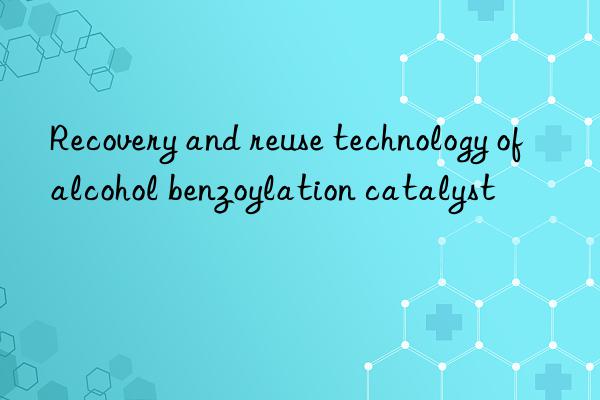
The benzoylation reaction of alcohols occupies an important position in the field of organic synthesis. It can not only protect the alcohol hydroxyl group, but also be used to construct complex of organic molecules. This process usually requires the participation of a catalyst to improve the efficiency and selectivity of the reaction. The recycling and reuse of catalysts is not only an economic consideration, but also a key strategy to respond to the principles of green chemistry, reduce waste emissions and conserve resources. This article will provide an in-depth look at recovery and reuse technologies for alcohol benzoylation catalysts, including their importance, current technology, and future trends.
The importance of catalyst recovery
The cost of catalysts, especially those based on precious metals such as platinum, palladium, rhodium, is often prohibitive. Not only are these precious metals expensive, but their resources are limited. Catalyst recycling therefore not only significantly reduces production costs but also reduces the need for scarce resources. In addition, the recycling and reuse of catalysts reduces environmental impact, as improper disposal of spent catalysts can lead to heavy metal contamination, which can harm ecology and human health.
Existing recycling technologies
Recycling of solid catalyst
For solid catalysts, physical recovery is the straightforward method. This involves simple filtration or centrifugation to separate the catalyst from the reaction mixture. The advantage of solid catalysts is that they are easy to separate and in many cases can be reused multiple times without additional processing.
Recycling of homogeneous catalyst
The recovery of homogeneous catalysts is more complicated because they are usually dissolved in the reaction medium. A common recovery method is to precipitate the catalyst by adding ligands or additives, followed by separation by filtration or centrifugation. Another method is to use supercritical fluid extraction, which is particularly suitable for systems that are difficult to separate.
Recycling of precious metal catalysts
The recovery of precious metal catalysts usually involves more specialized technology and equipment. The acid-base method is a commonly used technique that uses a specific acid or alkali solution to dissolve precious metals and then recover them through reduction or other chemical means. In recent years, some new technologies such as ionic liquid extraction and membrane separation technology have gradually been applied to the recovery of precious metal catalysts.
Recycling technology
Reuse of a catalyst often requires an assessment of whether its activity and selectivity remain unchanged. Catalyst regeneration may include cleaning, drying and reactivation. For example, for some precious metal catalysts, oxygen treatment at high temperatures can remove impurities adsorbed on the surface and restore their activity.
Future trends and challenges
Green recycling technology
With the development of green chemistry, environmentally friendly catalyst recovery technology has become a research hotspot. The increasing use of biodegradable materials and biotechnology in catalyst recovery can help reduce the use of chemical reagents and the generation of waste.
Smart Catalyst
The design and development of intelligent catalysts is also a trend in the future. This type of catalyst can automatically deactivate or aggregate after the reaction, making it easy to recycle. In addition, through the dynamic regulation of smart catalysts, precise control of the reaction process can be achieved, further improving efficiency and selectivity.
Multifunctional catalyst
Multifunctional catalysts, that is, catalysts that can catalyze multiple reaction steps at the same time, can simplify the production process, reduce the amount of catalyst used, and also reduce the difficulty and cost of recycling.
Conclusion
Catalyst recovery and reuse technology is an indispensable part of the modern chemical industry. By adopting advanced recycling methods and catalyst regeneration technology, not only can production costs be reduced, but pressure on the environment can also be reduced. With the advancement of science and technology, it is expected that more efficient and environmentally friendly catalyst recovery and reuse solutions will appear in the future, promoting the development of the chemical industry in a more sustainable direction. However, to achieve this goal, researchers need to make more efforts in catalyst design, recycling process optimization and green chemistry technology development.
Extended reading:
T120 1185-81-5 di(dodecylthio) dibutyltin – Amine Catalysts (newtopchem.com)
DABCO 1027/foaming retarder – Amine Catalysts (newtopchem.com)
DBU – Amine Catalysts (newtopchem.com)
bismuth neodecanoate – morpholine
amine catalyst Dabco 8154 – BDMAEE
2-ethylhexanoic-acid-potassium-CAS-3164-85-0-Dabco-K-15.pdf (bdmaee.net)



 微信扫一扫打赏
微信扫一扫打赏
